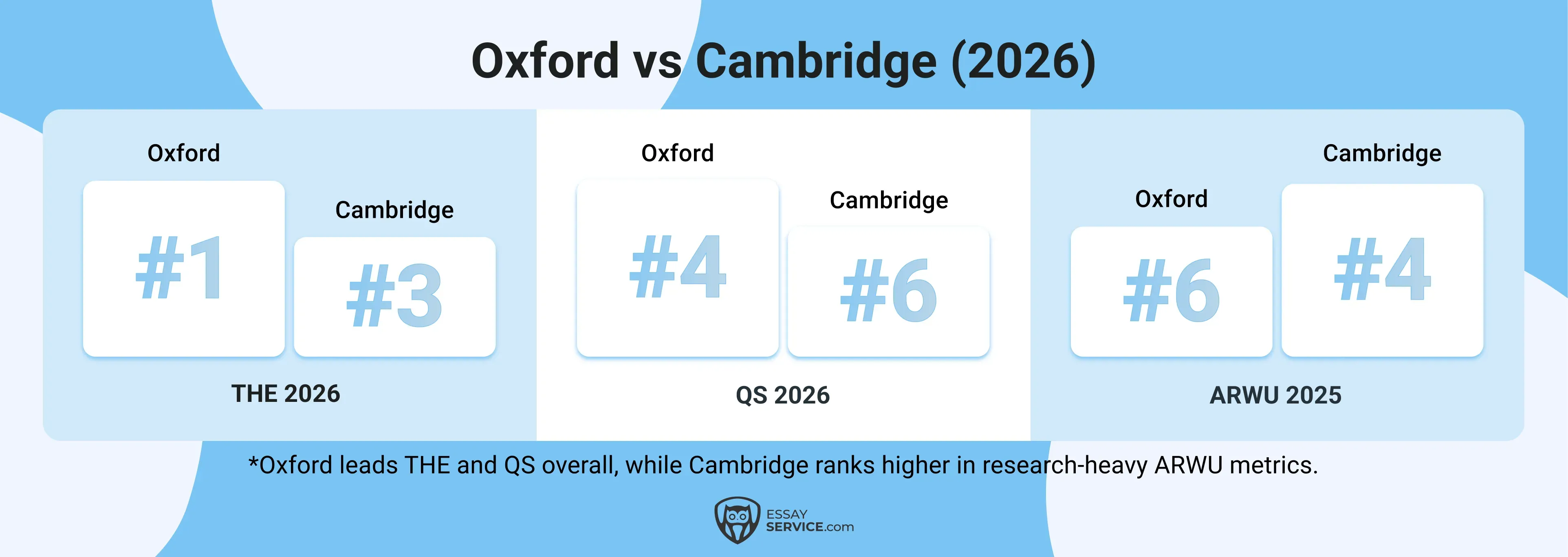Key Takeaways
- Oxford leads global rankings, with Cambridge close behind and stronger in research tables.
- Oxford suits students who prefer essay-based learning, while Cambridge aligns with those who benefit from structured supervisions and science-focused courses.
- Oxford feels compact and walkable; Cambridge spreads out with a bike-based routine.
- Both have high international fees but offer solid scholarships and bursary options.
- Graduates from both universities see strong employment, further study, and employer access.
In global rankings, Cambridge vs Oxford competition remains close. The University of Oxford holds the top position in the Times Higher Education World University Rankings 2026, followed by the University of Cambridge at #3. Course performance varies by field. Oxford excels particularly in the social sciences, business, and economics, while Cambridge leads the way in the life sciences and physical sciences.
In this article, we’ll break down how the two universities rise and fall in major rankings and what that means for someone choosing a course. Applicants often feel the pressure of juggling school deadlines with admissions essays, which is why so many turn to EssayService for guidance that keeps their writing clear and steady.


EssayService for Every Stage of Your Academic Path
Stronger applications today, reliable assignment help throughout university.
Oxford and Cambridge in Global & UK Rankings
Ranking data highlights the long-standing Oxford and Cambridge rivalry, and numbers show how close the competition remains. Oxford keeps the top position in the latest Times Higher Education results, and Cambridge moves within a close range after climbing slightly from its previous spot. QS rankings record small shifts for both universities, reflecting how Cambridge and Oxford rankings sometimes trade places year to year. Recent ARWU data places Cambridge ahead following a rise in research metrics.
The movement is usually small, yet it shows how each university responds to global research trends, employer reputation, and academic performance. The table below gives the most recent numbers side by side.

Oxford vs Cambridge Overview and Key Facts
The sections below walk you through the difference between Oxford and Cambridge, mainly the parts that matter most to applicants: location, costs, academics, admissions, traditions, social life, and graduate outcomes.
Location
Oxford and Cambridge location differences stand out immediately. Oxford feels more urban in atmosphere, with a busier central area. The city has more street noise, late-evening movement, and a more casual blend of shoppers, locals, and students. The streets weave together in a way that creates a kind of intellectual bustle. Movement continues throughout the day, and the small shops extend into pedestrian lanes shaped by centuries of use.
Cambridge has a lighter pace. You’ll notice bikes everywhere because the town is built around a cycling culture. The town feels structured around study, with compact streets and quiet routes that make it easier to stay focused and move between your commitments without much distraction.
Oxford carries more urban energy, while Cambridge offers a quieter, riverside environment. Both sit inside England’s academic core, but the atmosphere of each city works on your mind in its own way.
Cost and Funding
Both Oxford and Cambridge are expensive, especially for international students, not only in tuition but also in living and daily expenses. Let’s look at tuition fees and fee statuses, living cost estimates for the town, and what scholarships/bursaries you might qualify for.
Overview of Academics
The University of Oxford and the University of Cambridge structure their academic programmes differently. Let’s see how they compare.
Oxford:
At Oxford, students belong to a department and a college. The department runs lectures, practical classes, and the wider curriculum, while the college provides close-up teaching. Humanities subjects lean heavily on tutorial essays and deep reading. Sciences rely more on problem sheets, labs, and structured classes.
The tutorial method is a central approach to studying. Most of them involve one student and a tutor. Students prepare essays or problem sets before each tutorial meeting.
Assessment usually depends on written exams, with the work you do for tutorials contributing to your development throughout the year.
Cambridge:
At Cambridge, supervisions replace Oxford’s tutorials. These sessions usually involve one supervisor and a very small group of students.
Cambridge is especially strong in natural sciences and mathematics. Students spend a lot of time in labs, larger lectures, and detailed supervision discussions. Humanities students rely more on reading and written work, but the supervision system anchors the feedback cycle.
Assessment relies mostly on end-of-year exams, with supervision work guiding your preparation.
Application Process
Oxford and Cambridge acceptance rate for international students and UK/Home students are very low, and both schools expect strong grades, sharp test performance, and steady academic focus. The table gives you a quick snapshot of what the application process typically looks like.
Traditions
Tradition sits close to the surface at both universities. Oxford is known for its sub fusc tradition, when students wear traditional academic attire during formal exams. May Morning pulls people out of their rooms before sunrise so they can stand under Magdalen Tower and listen to the choir sing. Rowing adds to that atmosphere with far more noise and activity, especially during major races. Torpids and Summer Eights turn the river into a long strip of splashing, shouting, and bikes racing along the towpath trying to keep up with their crews.
Cambridge traditions move differently. The best example might be the May Balls. People talk about them as if they’ve stepped into another century. One college might add small rides or themed setups for the night. Another might focus on lighting, music, and food that keep the event going late. And the river remains a central part of the setting. The Cam shapes the way Cambridge students experience their place in the city. When exams end, the banks fill with students. People punt, sit in the grass, or wander into long afternoons.
Social Scene
Social life at Oxford feels centralised mainly because everything sits so close together. Most colleges are a short walk from the busy parts of the city, so getting to a pub, a café, the library, or a club rarely takes long. Nights out usually center around a small number of well-known venues. Students lean on JCR events, subject societies, and college sports, so your circle builds fast through the people you live with and the people in your course.
Cambridge spreads activity across a wider area, so students move between colleges, lecture sites, and social spaces by bike. This creates slightly more separation between groups, and college events take on a bigger role because students don’t always gather in the same central places. There are fewer clubs than in Oxford, so formals, college parties, and society events fill most of the social calendar.
In short:
- Oxford has more nightlife variety.
- Cambridge relies more on college-run events and outdoor meet-ups.
- Oxford feels slightly more compressed into the city center.
- Cambridge social groups spread across town because students cycle everywhere.
- Both universities depend heavily on colleges for your day-to-day social world.
Graduate Outcomes and Career Support
Graduate outcomes at Oxford and Cambridge stay consistently strong across subjects. The table below shows how each university compares in employment, further study, salaries, and career support.
Choosing the Best Fit for Your Goals
Choosing between Oxford or Cambridge usually becomes easier once you focus on how you study and what kind of day-to-day life helps you do your best.
- Teaching style is the first big filter. Oxford’s one-to-one tutorials suit students who think through writing and conversation, while Cambridge’s supervisions feel more structured if you like clear steps and steady problem-solving.
- Your subject should guide you too. Some fields grow stronger roots in one place, especially the natural sciences at Cambridge and several humanities areas at Oxford. Looking closely at first-year course outlines can tell you more than any ranking.
- Location plays a real role, too. Oxford is easier to navigate on foot, while Cambridge spreads out, relies on cycling, and gives you more open space around your routine. Many students realise they prefer the pace of one city over the other once they imagine a normal week there.
EssayService: Your Long-Term Writing Partner
We guide your admissions writing and assist with coursework when you need it.
The Bottom Line
Ultimately, choosing between Oxford and Cambridge comes down to where you can envision yourself working, thinking, and managing academic pressure in a way that feels healthy and manageable. Both universities rank among the top global institutions and deliver strong academic results. The differences appear in the details, such as course structure, city layout, college culture, and social scene.
Applicants often juggle school deadlines and admissions essays, so many rely on EssayService for steady writing support. With a simple ‘write an essay for me’ request, the application process and university coursework become easier to manage.
Frequently Asked Questions
Which Is Better Oxford or Cambridge?
Neither is ‘better’. The choice depends on a student’s approach to studies and career goals. Oxford suits students who prefer essay-based tutorials, while Cambridge fits those who want structured supervisions and strong science or math pathways.
Which Is More Prestigious Oxford or Cambridge?
Both are prestigious universities, but Oxford often appears higher in international rankings, while Cambridge performs exceptionally well in research-focused tables.
Can You Apply to Both Oxford and Cambridge?
No. Undergraduate applicants can submit an application to only one institution per admissions cycle. Postgraduate applicants are allowed to apply to both.
Are Oxford and Cambridge the Same?
No. They share a collegiate structure and strong academic reputation, but their teaching systems, course designs, city environments, and student cultures differ in clear ways.
Is Oxford Bigger Than Cambridge?
Neither school has a single campus. Both are spread across their cities. As a city, Oxford is larger and has a denser urban centre. Cambridge is smaller, more spread out, and built around a strong cycling culture.

Phil spends his working days teaching international trade. He contributes to our blog as a freelancer, leveraging his experience with MBA students to advise on academic writing, studying abroad, and securing funds.
- Times Higher Education. (2026). World University Rankings 2026.
https://www.timeshighereducation.com/world-university-rankings/latest/world-ranking - OSAP Abroad. (n.d.). The Oxford tutorial.
https://osapabroad.com/academics/the-oxford-tutorial/ - University of Cambridge. (n.d.). Supervisions and assessment.
https://www.undergraduate.study.cam.ac.uk/supervisions-and-assessment
New posts to your inbox
Your submission has been received!

.png)
.webp)
%20(1)%20(1).webp)